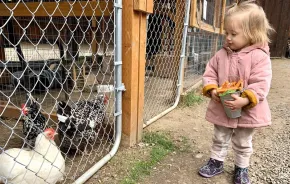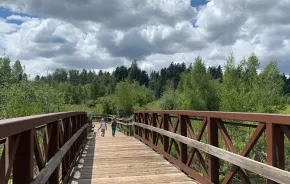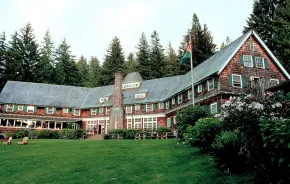
Photo:
Brave the snow for an adventure. Photo: Stephen Mitchell for The Bush School
Biking is officially a four-season sport. Equipped with oversized tires that are kept at low pressure, so-called fat bikes are trail-ready almost anytime, anywhere — including on soft or slippery surfaces such as sand, mud and even snow.
This terrain versatility makes fat biking a perfect fit for cold-weather adventures for Northwest families. Fat biking is a great way to explore Washington’s winter landscapes, one that is easy to combine with other snow-time fun — say, a stop to build a snowman or to have an impromptu snowball fight.
When the next Snowpocalypse hits the Seattle area, biking through the snow will make a simple cruise through town to get a cup of hot cocoa all the more exciting. And planning a trip to a more extensive trail network makes for an active family getaway that is more affordable than resort skiing.

Fat biking is an all-ages family sport
A bike carrier outfitted with ski attachments makes it easy to take the little ones along for the ride, and fat bikes are available in smaller sizes, making it possible for older kids to ride alongside. The best part? Chances are good that you already know how to do it, even if you’ve never actually biked on snow before.
“Pretty much everyone knows how to ride a bike, so all you need to do is get up and go,” says Erika Halm, outreach and access manager at Methow Trails in North Central Washington. “It’s just like riding a normal bike, but you’re magically floating on top of the snow.”

3 fat-biking spots for Seattle-area families
1. Methow Valley
Methow Trails offers the largest cross-country ski trail system in North America and is a pioneer of fat biking in the lower 48 states. “When we first offered fat biking, we thought we were on the leading edge — but now everyone is doing it,” says Halm. Still, Methow Trails holds its place as the local gold standard.
The organization opens about 35 kilometers of routinely groomed trails to fat bikers: some multi-use trails that are shared with skiers and snowshoers, and some trails that are reserved exclusively for cyclists. Trail conditions are posted on the organization’s website, so it is easy to make a plan based on current conditions (fat biking becomes more challenging the longer it has been since the trails have been groomed and also more challenging in soft, mushy snow). Some of the trails are even open to dogs, making it possible for the whole crew to tag along.

For those looking for a bigger adventure, Methow Trails partners with Rendezvous Huts to groom trails to make several remote cabins accessible in winter. You can get to one of them — the Grizzly Hut — via fat bike. “I’ve taken my 2-year-old to the huts, and it’s worked out great,” says Halm. “Like anything, you have to be prepared to bring a lot of stuff, but she loves it.”
Outside of the Methow Trails network and about 3 miles northeast of Winthrop, Pearrygin Lake State Park and adjacent Lloyd Ranch open numerous trails to fat bikers.
Fat bike rentals are available at Methow Cycle & Sport. Winthrop is about a 4.5-hour drive from Seattle in winter.

2. Central Cascades
The Leavenworth Ski Hill, operated by the Leavenworth Winter Sports Club (LWSC), is the epicenter of cross-country snow sports in the Central Cascades, and that includes winter cycling. Fat biking is allowed on a portion of the Golf Course and Ski Hill’s snowshoe trails, and the Nordic ski trails in the evenings. Five kilometers of these trails are lighted; you can ride additional trails with a bike-mounted headlight or a headlamp. Be sure to check for closures and trail conditions ahead of time. Fat bike rentals are available from Eastside Cycleworks in Leavenworth.
In nearby Wenatchee, Squilchuck State Park offers several miles of groomed trails that are open to fat bikers. Leavenworth is about a 2.5-hour drive from Seattle; Wenatchee is an additional 30 minutes east of Leavenworth.

3. White Pass
The White Pass Nordic Center is home to 26 kilometers of groomed trails and families will find it’s one of the most low-key cross-country ski outfits in the Pacific Northwest. Its relatively high elevation also means it gets lots of the fluffy white stuff. The center’s rental shop outfits fat bikes, and allows them on their trails when conditions permit (as in, when the bike tires won’t leave a rut in the snow that could interfere with cross-country skiers). Dogs are also allowed on the trails beginning at 3:30 p.m., so it’s another good option when a family wants to include Fido in the fun.

Fat-biking tips for families
Find a set of wheels
Be sure to call ahead to make a reservation if you plan to rent a fat bike or chariot. If you have difficulty finding a child-sized fat bike, ask if the rental business has plus-sized mountain bikes, says Patrick Walker, former marketing manager at Evergreen Mountain Bike Alliance. The tires of plus-sized bikes are 2.8 inches wide, which should be big enough to stay on top of the snow bearing the lighter weight of a child. For adult bikes, the tires need to be at least 3.75 inches wide and filled to around 6 psi.
Layer up
“Dress as you would for Nordic skiing,” Walker recommends. “Even though it’s cold out, you’re going to be active. But do wear shoes that will keep your feet warm — not your normal biking shoes.” If you are pulling children in a chariot, remember that you will be doing all the work, so bundle them up!
Conditions matter
“Temperature makes a big difference in terms of when to go,” says Walker. As a general rule: the colder, the better. Cold snow will be easier to ride on because it’s firmer; pedaling will take more effort or even become impossible as things warm up and the snow softens.

Know the rules
Just as on a multi-use trail in the summer, cyclists must yield to other trail users (in this case, snowshoers and cross-country skiers). Stay out of groomed classic cross-country tracks if you encounter them because the bike tires will widen the tracks, making it more difficult for skiers. Many groomed trails will close if conditions get too soft; as a general rule, if you leave a rut that is more than an inch deep you should not be riding.
Go for a test run
While riding fat bikes requires the same basic skills as normal cycling, it does have a different feel to it and can take some getting used to. Plus, notes Walker, “Your easiest trail is going to become more challenging when there’s snow on it.” Keep things fun by starting off easy; assess everyone’s abilities and then ramp up to harder trails only when everyone is ready.
That being said, the fun of fat biking usually comes easily — and learning the ropes is often a part of that. “The great thing about riding in snow is if you do topple off, it’s usually just a cause for laughter,” says Halm. “It’s hard to get hurt.”

Closer to Seattle
While the best groomed trails available to fat bikers are a bit of a trek from Seattle, there are also fat biking options that are closer to home.
“If you want to ride a fat bike, all you really need to do is get ahold of one,” says Walker. If there are fewer than 6 inches of snow, you can ride fat bikes anywhere — for example, a good choice could be along the Palouse to Cascades Trail, part of Iron Horse State Park, about an hour’s drive east from Seattle.
If you plan to ride on more than 6 inches of snow, you want to make sure you’re traversing a firm, packed surface. Otherwise, you’ll be spending your time pushing your bike rather than riding it.
More winter activities for Seattle-area families: |
Editor’s note: This article was originally published in 2019 and most recently updated in January 2025 by ParentMap’s family fun editor, Meredith Charaba, to include a thorough fact-check and new details for fat biking this season.











